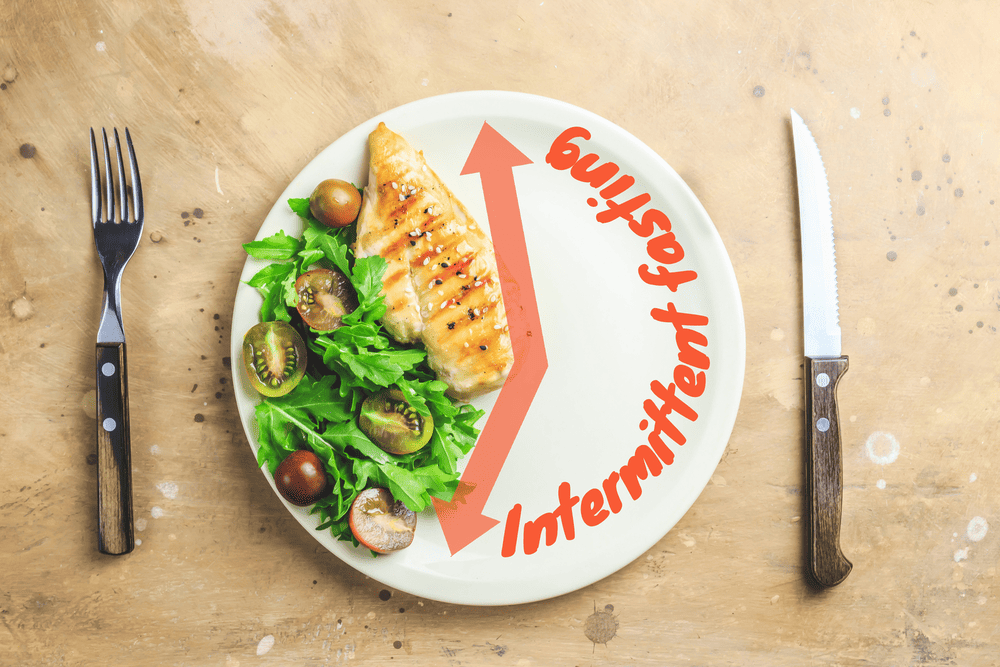Are you a woman over 50 looking for a weight loss method that works with your body’s unique needs? Look no further! “Lose weight with intermittent fasting for women over 50” might be the answer you’ve been searching for, offering an array of benefits for both weight loss and overall health. Get ready to embark on an exciting journey to revitalize your body and shed those stubborn pounds.
Short Summary
-
Intermittent fasting is an effective weight loss tool for women over 50, helping to combat hormonal changes and slower metabolism.
-
Start your journey safely by consulting with a healthcare provider and gradually increasing duration.
-
Combine intermittent fasting with healthy diet, exercise & mindful hunger management for successful weight loss!
Understanding Intermittent Fasting

Intermittent fasting has gained popularity in recent years, and for good reason. This weight loss method involves cycling between periods of eating and fasting, providing numerous health benefits that cater specifically to women over 50.
By incorporating intermittent fasting into your lifestyle, you can lose weight, improve digestion, and increase energy levels.
Types of Intermittent Fasting
Unlike fad diets, intermittent fasting offers a variety of methods to choose from. The 16/8 method, 5:2 diet, and alternate-day fasting are all popular options that cater to different lifestyles and preferences.
Whether you’re a busy professional or a stay-at-home mom, there’s a fasting method that fits your schedule and goals.
Benefits of Intermittent Fasting
Intermittent fasting boasts a multitude of benefits, ranging from weight loss to improved insulin sensitivity and increased energy. Managing your calorie intake, cutting back on sugary foods, and incorporating nutrient-dense, fiber-rich foods can help you achieve your weight loss goals while lowering your risk of diabetes and other chronic diseases.
By combining intermittent fasting with a balanced diet and regular physical activity, you’ll be on the fast track to sustainable weight loss and a healthier lifestyle.
Why Intermittent Fasting Works for Women Over 50

Intermittent fasting is particularly effective for women over 50 due to hormonal changes and a slower metabolism that can make weight loss more challenging. As we age, our bodies produce less estrogen and progesterone, leading to menopause and its associated symptoms. Furthermore, our metabolism gradually slows down, making it harder to shed those stubborn pounds.
But worry not – intermittent fasting can help combat these challenges and set you on the path to weight loss success.
Hormonal Changes
During menopause, hormonal changes can lead to weight gain and increased fat storage. However, intermittent fasting has the potential to:
-
Balance hormones
-
Promote weight loss
-
Reduce insulin levels
-
Increase the production of human growth hormone (HGH)
This powerful combination can help your body burn fat more effectively, making intermittent fasting a valuable tool for women over 50.
Intermittent fasting can be a great way to improve overall health and wellness during menopause.
Slower Metabolism
A slower metabolism in older women can make it harder to lose weight, but intermittent fasting can help increase metabolic rate and burn fat more efficiently. By building muscle mass, staying active, and eating nutritious foods, you can maintain a healthy metabolism as you age.
Intermittent fasting can also boost the body’s production of human growth hormone (HGH), which helps to build muscle mass and increase metabolic rate. Furthermore, fasting can reduce insulin levels, aiding the body in burning fat more efficiently.
By combining intermittent fasting with a healthy diet and regular exercise, you can overcome the challenges of a slowing metabolism and achieve your weight loss goals.
How to Start Intermittent Fasting Safely

Starting intermittent fasting safely involves choosing the right method and gradually transitioning into the fasting routine. It’s essential to consult your healthcare provider before beginning intermittent fasting to ensure it’s a suitable option for you to get to a healthy weight. Once you have your healthcare provider’s approval, consider starting with a 12-hour fasting period and gradually increasing the duration under medical supervision or after consulting with a healthcare provider.
It’s important to listen to your body and adjust the fasting period accordingly. Make a Difference.
Choose the Right Method
Select a fasting method that suits your lifestyle and preferences, considering factors such as daily schedule, hunger levels, and health conditions. Explore options like the 16/8 method, 5:2 diet, or alternate-day fasting to find the perfect fit for you.
Each of these methods has its own benefits and drawbacks, so it’s important to do your research.
Losing weight is the goal so we want to do this safely.
Gradual Transition
To minimize potential side effects, it’s important to ease into intermittent fasting by slowly increasing fasting periods and reducing eating windows. Here’s how you can start.
-
Skip one meal, such as breakfast, and gradually extend the fasting duration to match your chosen method.
-
Allow your body to adapt to the new routine to help you lose weight safely and effectively.
Intermittent fasting can be a great way to lose weight and improve overall health. However, the problem persists.
Combining Intermittent Fasting with a Healthy Diet

Combining intermittent fasting with a healthy diet is crucial for optimal weight loss and overall health. Ensuring adequate nutrition during your eating windows can help you lose weight while maintaining energy levels and supporting your body’s essential functions. Plus, consuming nutrient-dense foods can help you feel full and satisfied, making it easier to stick to your fasting schedule.
Making sure you get the right nutrients during your eating windows is key to successful fasting. Eating.
Nutrient-Dense Foods
Focus on nutrient-dense foods, such as:
-
fruits
-
vegetables
-
lean proteins
-
whole grains
-
healthy fats, including olive oil
To ensure you’re providing your body with the essential nutrients it needs during your eating periods. These powerhouses of nutrition will help fuel your body and support your weight loss journey while intermittent fasting.
Avoiding Processed Foods
Processed foods and added sugars can hinder weight loss and negatively impact health. These foods are often high in calories, unhealthy fats, and artificial ingredients, which can lead to weight gain and other health issues over time. It’s important to be mindful of how many calories you consume from these sources to avoid potential health problems.
Instead, opt for whole, unprocessed foods that provide essential nutrients and support your weight loss efforts. By avoiding processed foods and focusing on nutrient-dense options, you can maximize the benefits of intermittent fasting and achieve lasting weight loss.
Remember, the key to success with any weight loss plan is to maintain a balanced diet and prioritize your overall health and well-being, ultimately achieving a healthy weight by aiming to lose weight gradually. Incorporating losing weight into your lifestyle can make a significant difference in your overall well-being, and maintaining weight loss is a crucial aspect of this journey.
Exercise and Intermittent Fasting

Exercise is an important component of weight loss and can be effectively combined with intermittent fasting. Engaging in regular physical activity not only helps you burn calories, but also boosts your metabolism and improves your overall fitness level.
By incorporating exercise into your intermittent fasting routine, you can optimize your weight loss results and maintain a healthy lifestyle.
Types of Exercise
Incorporate a variety of exercises, including:
-
Cardio exercises, such as walking or jogging, to help you burn fat and improve insulin resistance
-
Strength training to build muscle mass and increase your metabolism
-
Flexibility exercises to improve your range of motion and prevent injuries
By including these different types of exercises in your fitness routine, you can promote overall fitness and start losing weight.
Flexibility exercises, like yoga and Pilates, can enhance your range of motion and reduce stress, further supporting your weight loss journey.
Timing Your Workouts
Time your workouts to coincide with your eating window to ensure adequate energy and nutrient intake for optimal performance and recovery. By scheduling your exercise sessions during your eating periods, you can fuel your body with the necessary nutrients and energy it needs to perform at its best.
Additionally, exercising during your eating window can help prevent feelings of fatigue or lightheadedness that may occur during fasting periods. This will allow you to maximize the benefits of both intermittent fasting and exercise, setting you on the path to sustainable weight loss success.
Tips for Success with Intermittent Fasting

Staying hydrated and managing hunger effectively are crucial for success with intermittent fasting. Drinking plenty of water throughout the day, especially during fasting periods, can help you stay hydrated and reduce hunger.
Additionally, consuming high-fiber, high-protein foods during your eating periods can keep you feeling full and satisfied, making it easier to stick to your fasting schedule.
Staying Hydrated
Drinking plenty of water throughout the day is essential for staying hydrated and reducing hunger while intermittent fasting. Aim to drink at least eight 8-ounce glasses of water daily to support your body’s functions and help manage hunger during fasting periods.
Staying well-hydrated can also aid in digestion and contribute to overall health.
Managing Hunger
To effectively manage hunger during fasting periods, practice mindful eating and employ strategies such as distraction to help you stay focused on your weight loss goals. By being mindful of your emotional state and recognizing when you’re eating out of emotions rather than hunger, you can better control your eating habits and avoid overeating.
Remember, the key to successful intermittent fasting is to listen to your body and adjust your fasting schedule according to how you feel.
Common Challenges and How to Overcome Them

Intermittent fasting can present some challenges, such as navigating social situations and dealing with emotional eating. However, by finding solutions to these common obstacles, you can stay on track and maintain your weight loss momentum.
For example, if you’re invited to a dinner party, you can plan ahead and bring a table.
Social Situations
Navigating social situations while intermittent fasting can be tricky, but it’s possible with some planning and communication. Share your fasting schedule with friends and family so they can understand and support your dietary choices.
Plan your meals and snacks ahead of time and focus on engaging in conversations and activities to keep yourself distracted from food. Remember, intermittent fasting is flexible and can be adapted to fit your social life.
Emotional Eating
Addressing emotional eating while intermittent fasting involves identifying triggers, practicing mindfulness, and seeking support from friends, family, or a professional. By understanding your emotional triggers and finding alternative ways to cope with emotions, you can prevent emotional eating and stay on track with your weight loss goals.
If emotional eating becomes a persistent issue, consider seeking professional help or guidance. Remember, the key to successful weight loss is to maintain a balanced lifestyle and prioritize your overall health and well-being.
Summary
Intermittent fasting offers a fresh approach to weight loss for women over 50, addressing common challenges like hormonal changes and slower metabolism. By combining intermittent fasting with a healthy diet, regular exercise, and effective strategies for managing hunger and social situations, you can achieve sustainable weight loss and improve your overall health. Embrace the power of intermittent fasting and begin your journey to a healthier, happier you.
Frequently Asked Questions
How many hours should a 50 year old woman intermittent fast?
For women over 50, intermittent fasting can be started at 12-13 hours and gradually worked up to 18-20 hours.
This approach can give you great results!
How much weight can a woman lose in a month on intermittent fasting?
With intermittent fasting and healthy lifestyle habits, you can expect to lose 6-8 pounds per month. This is an effective and fast rate of weight loss without compromising your health.
What are the main benefits of intermittent fasting for women over 50?
Intermittent fasting can be a great way for women over 50 to lose weight, boost energy levels and improve digestion, as well as balance hormones affected by menopause.
It has been shown to reduce inflammation, improve insulin sensitivity, and reduce the risk of chronic diseases such as diabetes, heart disease, and cancer.
Intermittent fasting can also help to reduce stress levels, improve mental clarity, and increase energy levels.
How can I choose the right intermittent fasting method for me?
Choose the intermittent fasting method that aligns best with your daily activities, hunger levels, and health conditions for a safe and successful fasting experience.
This will help you to ensure that you are following the best fasting plan for your individual needs.
What types of exercise should I incorporate while intermittent fasting?
Intermittent fasting calls for engaging in a variety of exercises, like cardio, strength training, and flexibility exercises, to stay fit and reach your weight loss goals.
